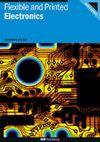通过金属配体交联的柔性、自愈合和可降解聚合物电介质用于电阻式存储器件
IF 3.2
4区 工程技术
Q3 MATERIALS SCIENCE, MULTIDISCIPLINARY
引用次数: 0
摘要
自愈能力是自然界的一个重要特征,生物体在受到轻微伤害时可以自我修复。随着人们对环境可持续性的日益重视,仿生自愈合聚合物材料的概念已成为一个突出的趋势,有望显著延长产品的使用寿命和可靠性。研究表明,生物体内三分之一的蛋白质需要金属辅助因子才能正常发挥作用。众所周知,蛋白质与金属之间的相互作用可提高某些生物材料的性能,而金属和配体的不同选择可产生不同的材料特性,影响材料的硬度、韧性、附着力和自愈能力等特性。明胶是一种天然聚合物,由胶原蛋白水解而来,其独特的氨基酸结构带来了广泛的应用。在这项研究中,通过引入铝离子与明胶中的羧基形成金属配位复合物,构建了一种具有自愈合特性的弹性网络。这种明胶基材料被用作电阻开关器件的绝缘层。此外,通过使用相同成分的明胶基底,该装置还表现出很强的界面粘附性。基于自愈合明胶薄膜的设备具有出色的电气性能和机械性能。即使在自愈合后,它仍能保持高达 105 的高导通/关断比和集中的开关参数分布。在令人信服的物理和电学证据的支持下,这项研究为绿色电子设备中的仿生物材料提供了重要的发展机遇。本文章由计算机程序翻译,如有差异,请以英文原文为准。
Flexible, self-healing, and degradable polymeric dielectrics cross-linked through metal–ligand for resistive memory device
The ability to self-heal is a crucial feature in nature, where living organisms can repair themselves when subjected to minor injuries. With an increasing emphasis on environmental sustainability, the concept of biomimetic self-healing polymeric materials has emerged as a prominent trend, promising to significantly extend the lifespan and reliability of products. Studies have shown that one-third of proteins in living organisms require metal cofactors to function properly. It is known that protein-metal interactions can enhance the performance of certain biomaterials, and different choices of metals and ligands can create diverse material properties, influencing characteristics such as hardness, toughness, adhesion, and self-healing abilities. Gelatin is a natural polymer derived from the hydrolysis of collagen, and its unique amino acid structure has led to a wide range of applications. In this research, by introducing aluminum ions that form metal coordination complexes with the carboxyl groups in gelatin, an elastic network with self-healing properties was constructed. This gelatin-based material was utilized as an insulating layer in resistive switching devices. Furthermore, by employing a gelatin substrate of the same composition, the device demonstrated strong interfacial adhesion. The device based on the self-healing gelatin film exhibited excellent electrical performance and mechanical properties. Even after self-healing, it maintained a high ON/OFF ratio of up to 105 and a concentrated distribution of switching parameters. Supported by compelling physical and electrical evidence, this study showcases significant development opportunities for biomimetic materials in green electronic devices.
求助全文
通过发布文献求助,成功后即可免费获取论文全文。
去求助
来源期刊

Flexible and Printed Electronics
MATERIALS SCIENCE, MULTIDISCIPLINARY-
CiteScore
4.80
自引率
9.70%
发文量
101
期刊介绍:
Flexible and Printed Electronics is a multidisciplinary journal publishing cutting edge research articles on electronics that can be either flexible, plastic, stretchable, conformable or printed. Research related to electronic materials, manufacturing techniques, components or systems which meets any one (or more) of the above criteria is suitable for publication in the journal. Subjects included in the journal range from flexible materials and printing techniques, design or modelling of electrical systems and components, advanced fabrication methods and bioelectronics, to the properties of devices and end user applications.
 求助内容:
求助内容: 应助结果提醒方式:
应助结果提醒方式:


